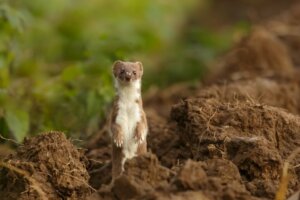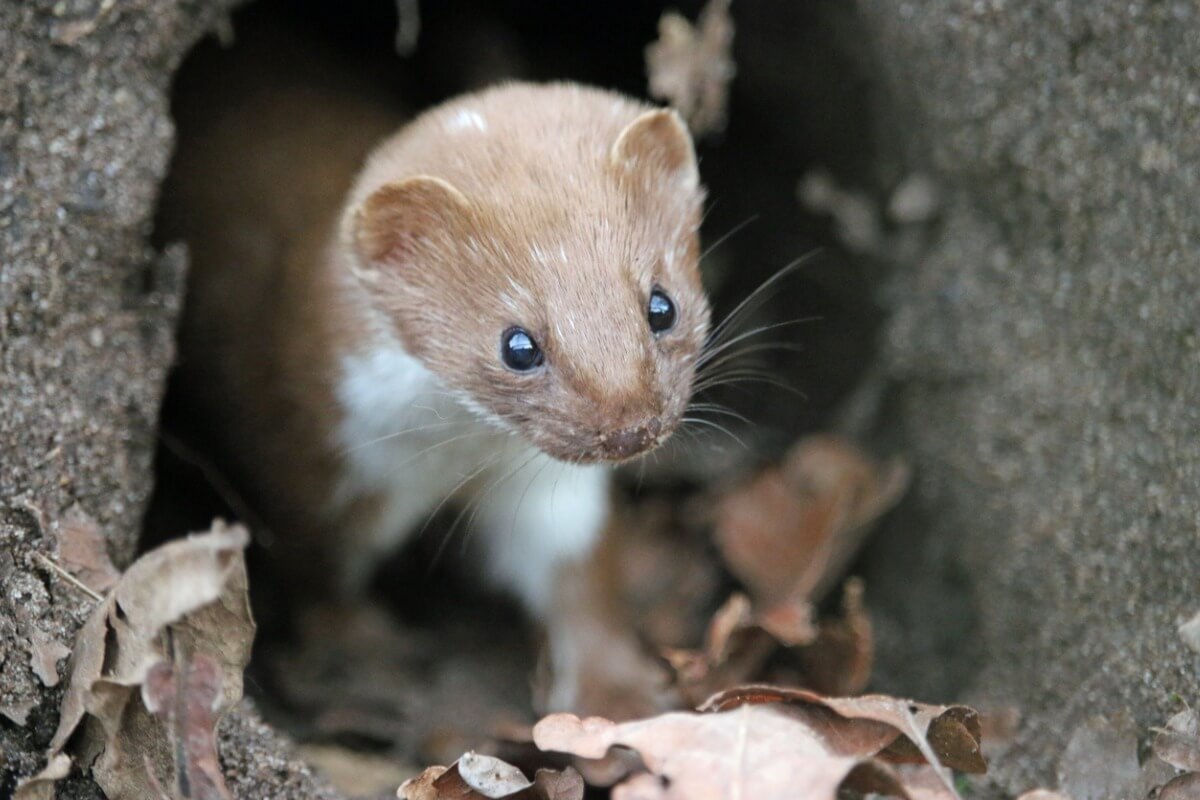What Do Weasels Eat?


Written and verified by the psychologist Sara González Juárez
This small, but ferocious, mustelid is found throughout the Northern Hemisphere, especially in southern Spain, North Africa, the United States, and Canada. Don’t be fooled by its adorable appearance: its eating habits involve infallible hunting techniques and a very marked aggressiveness. Find out what weasels eat and how they do it in this article.
In this article, you’ll find specialized information about the eating habits of the weasel. Don’t miss a single detail, because it’s very worthwhile to get to know every aspect of this small mustelid.
Characteristics of the weasel
The weasel (Mustela nivalis) is the smallest representative of the mustelid family. Its body, like that of all its relatives, is long, tubular, and flexible. The head is flattened, short-snouted, with rounded, flat ears and a long, slender neck.
Their fur is brown, but the weasels that live further north change their fur in winter to a snowy white. This way they blend in better with the snowy landscape.
There are about 10 recognized subspecies of weasel. However, they’re physically indistinguishable and differ only in geographic location. Because territory boundaries aren’t well defined, the scientific community still disagrees on the division of subspecies within this taxon.

Weasels occupy abandoned burrows for shelter and maintain an area of territory around them. In this area, they hunt and breed when the breeding season arrives. They prefer areas with a high density of bushes and tall grasses in order to hide from predators and stalk their prey.
The digestive system of the weasel
Before going into the actual feeding of weasels, it’s useful to know the characteristics of their digestive system. Digestion begins in the mouth: this mustelid has 34 teeth that follow the dental formula of 3/3 incisors, 1/1 canines, 3/3 premolars and 1/2 molars.
The rest of its digestive system is characterized by the great length of its small intestine, an organ in which fats and proteins are absorbed. The colon, however, is much shorter in comparison and doesn’t have a cecum, which means that these mammals can hardly extract any energy from plant matter.
Since this mammal swallows large chunks of food without chewing, digestion in the stomach takes a long time, as it needs large amounts of gastric acids to break it down. Afterwards, the food bolus advances through the rest of the digestive system until it’s excreted in the form of feces.
What weasels eat
As you may have deduced from the previous paragraphs, the weasel is a carnivorous animal. Weasels eat mainly small rodents, and it feeds on them exclusively if there are enough of them in the ecosystem.
The weasel has a very fast metabolism, so it’s able to consume 50% of its body weight in meat every day.
If there aren’t too many small rodents around, weasels eat any small animal within their reach. In a study carried out in the Parque Natural das Serras de Aire e Candeeiros (Portugal), the usual prey that make up the weasel’s diet were recorded, giving rise to quite illustrative data. We’ll show you some of them:
- Small rodents (60,6 %): Mice and rats
- Rabbits (14,2 %)
- Shrews and moles (3.9 %)
- Small birds (7.1%): Sparrows, pigeons, robins, quails, and other species of a similar size
- Reptiles (5.5%): Lizards, and even small snakes
- Amphibians (4.7%): Toads, frogs, salamanders, and tadpoles
- Fruits and seeds (4,4 %)
- Carrion: Very occasionally and only when live food isn’t available
An adult weasel measures about 30 centimeters (12 inches) from head to tail (females about 20 cm, 8 inches). Many of its prey are larger than them, but its size isn’t a problem when hunting them. If you want to know how it does it, keep reading and we’ll explain all.
Weasel hunting techniques
The weasel’s diet depends exclusively on the efficiency of its hunting, so it has developed very effective strategies when it comes to predation. It’s a slippery animal that moves quickly through the undergrowth, although it’s also a good climber and swimmer.
Often, the weasel traps its prey inside its own burrow, as it’s able to enter through openings up to 2.5 centimetres (1 inch) in diameter.
Their eyesight and sense of smell are highly developed, which allows these animals to detect prey with ease. They approach them with great stealth until they can pounce on them. Their technique consists of catching the victim by the nape of the neck with a quick bite, severing the spine, and killing it instantly.
Weasels are sometimes seen performing a series of erratic movements in front of their prey, known as the “war dance”. The exact function of this behavior isn’t known, but it’s thought to serve to confuse the victims before hunting them.
The weasel belongs to the native fauna of several countries, which is why its captive possession is prohibited in many of them. At present, Mustela nivalis is in a conservation status of Least Concern (LC).
Its importance as a controller of small animal populations and as prey for larger predators makes the preservation of this species, as well as that of its habitat, necessary. The weasel can’t be ignored if European forest ecosystems are to be maintained in good condition.
This small, but ferocious, mustelid is found throughout the Northern Hemisphere, especially in southern Spain, North Africa, the United States, and Canada. Don’t be fooled by its adorable appearance: its eating habits involve infallible hunting techniques and a very marked aggressiveness. Find out what weasels eat and how they do it in this article.
In this article, you’ll find specialized information about the eating habits of the weasel. Don’t miss a single detail, because it’s very worthwhile to get to know every aspect of this small mustelid.
Characteristics of the weasel
The weasel (Mustela nivalis) is the smallest representative of the mustelid family. Its body, like that of all its relatives, is long, tubular, and flexible. The head is flattened, short-snouted, with rounded, flat ears and a long, slender neck.
Their fur is brown, but the weasels that live further north change their fur in winter to a snowy white. This way they blend in better with the snowy landscape.
There are about 10 recognized subspecies of weasel. However, they’re physically indistinguishable and differ only in geographic location. Because territory boundaries aren’t well defined, the scientific community still disagrees on the division of subspecies within this taxon.

Weasels occupy abandoned burrows for shelter and maintain an area of territory around them. In this area, they hunt and breed when the breeding season arrives. They prefer areas with a high density of bushes and tall grasses in order to hide from predators and stalk their prey.
The digestive system of the weasel
Before going into the actual feeding of weasels, it’s useful to know the characteristics of their digestive system. Digestion begins in the mouth: this mustelid has 34 teeth that follow the dental formula of 3/3 incisors, 1/1 canines, 3/3 premolars and 1/2 molars.
The rest of its digestive system is characterized by the great length of its small intestine, an organ in which fats and proteins are absorbed. The colon, however, is much shorter in comparison and doesn’t have a cecum, which means that these mammals can hardly extract any energy from plant matter.
Since this mammal swallows large chunks of food without chewing, digestion in the stomach takes a long time, as it needs large amounts of gastric acids to break it down. Afterwards, the food bolus advances through the rest of the digestive system until it’s excreted in the form of feces.
What weasels eat
As you may have deduced from the previous paragraphs, the weasel is a carnivorous animal. Weasels eat mainly small rodents, and it feeds on them exclusively if there are enough of them in the ecosystem.
The weasel has a very fast metabolism, so it’s able to consume 50% of its body weight in meat every day.
If there aren’t too many small rodents around, weasels eat any small animal within their reach. In a study carried out in the Parque Natural das Serras de Aire e Candeeiros (Portugal), the usual prey that make up the weasel’s diet were recorded, giving rise to quite illustrative data. We’ll show you some of them:
- Small rodents (60,6 %): Mice and rats
- Rabbits (14,2 %)
- Shrews and moles (3.9 %)
- Small birds (7.1%): Sparrows, pigeons, robins, quails, and other species of a similar size
- Reptiles (5.5%): Lizards, and even small snakes
- Amphibians (4.7%): Toads, frogs, salamanders, and tadpoles
- Fruits and seeds (4,4 %)
- Carrion: Very occasionally and only when live food isn’t available
An adult weasel measures about 30 centimeters (12 inches) from head to tail (females about 20 cm, 8 inches). Many of its prey are larger than them, but its size isn’t a problem when hunting them. If you want to know how it does it, keep reading and we’ll explain all.
Weasel hunting techniques
The weasel’s diet depends exclusively on the efficiency of its hunting, so it has developed very effective strategies when it comes to predation. It’s a slippery animal that moves quickly through the undergrowth, although it’s also a good climber and swimmer.
Often, the weasel traps its prey inside its own burrow, as it’s able to enter through openings up to 2.5 centimetres (1 inch) in diameter.
Their eyesight and sense of smell are highly developed, which allows these animals to detect prey with ease. They approach them with great stealth until they can pounce on them. Their technique consists of catching the victim by the nape of the neck with a quick bite, severing the spine, and killing it instantly.
Weasels are sometimes seen performing a series of erratic movements in front of their prey, known as the “war dance”. The exact function of this behavior isn’t known, but it’s thought to serve to confuse the victims before hunting them.
The weasel belongs to the native fauna of several countries, which is why its captive possession is prohibited in many of them. At present, Mustela nivalis is in a conservation status of Least Concern (LC).
Its importance as a controller of small animal populations and as prey for larger predators makes the preservation of this species, as well as that of its habitat, necessary. The weasel can’t be ignored if European forest ecosystems are to be maintained in good condition.
All cited sources were thoroughly reviewed by our team to ensure their quality, reliability, currency, and validity. The bibliography of this article was considered reliable and of academic or scientific accuracy.
- Fragoso, S., Santos-Reis, M. (2000). Utilização dos recursos troficos pela doninha no Parque Natural das Serras de Aire e Candeeiros. Revista de Biologia, 18 (1-4): 23-32.
- Palazón, S., & Salvador Milla, A. (2017). Comadreja–Mustela nivalis (Linnaeus, 1761).
- Mustela nivalis (least weasel). (s. f.). Animal Diversity Web. Recuperado 24 de noviembre de 2021, de https://animaldiversity.org/accounts/Mustela_nivalis/
- Ibérica, F. (2011, 27 agosto). Comadreja (Mustela nivalis). Fauna Ibérica. Recuperado 24 de noviembre de 2021, de https://www.faunaiberica.org/comadreja
- McDonald, R.A., Abramov, A.V., Stubbe, M., Herrero, J., Maran, T., Tikhonov, A., Cavallini, P., Kranz, A., Giannatos, G., Kry�tufek, B. & Reid, F. 2019. Mustela nivalis (amended version of 2016 assessment). The IUCN Red List of Threatened Species 2019: e.T70207409A147993366. https://dx.doi.org/10.2305/IUCN.UK.2016-1.RLTS.T70207409A147993366.en. Downloaded on 24 November 2021.
This text is provided for informational purposes only and does not replace consultation with a professional. If in doubt, consult your specialist.








